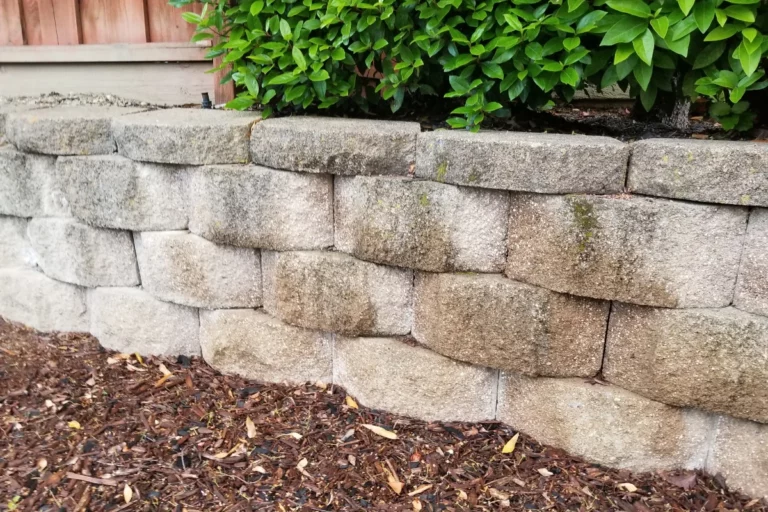The Role of Proper Drainage in Retaining Wall Longevity

Key to Stability and Durability
Retaining walls frequently encounter multiple stress types, among them the hydrostatic pressure caused by accumulated water behind the wall. In the absence of sufficient drainage, water may accumulate, applying significant pressure on the wall. This situation can cause damage or even lead to the wall’s collapse. Implementing appropriate drainage solutions is crucial for preserving the structural stability of your retaining wall.
Preventing Erosion and Wall Failure
One of the primary purposes of retaining walls is to prevent erosion by holding back soil. The soil behind the wall can become saturated with adequate drainage, leading to better drainage conditions. This affects the wall’s stability and can result in erosion and damage to your property.
Dealing with Poor Draining Soils
In some cases, the native soil behind the retaining wall may have poor drainage characteristics. This can exacerbate drainage issues. Implementing effective drainage solutions to address this is crucial, which we’ll explore later in this guide.
Common Drainage Issues with Retaining Walls
Water Accumulation Behind a Wall
Accumulation of water behind a retaining wall can be a serious source of problems. When this happens, hydrostatic pressure increases dramatically and could eventually cause it to collapse – hence why an efficient drainage system must be in place in order to avoid such scenarios.
Inadequate Drainage Stone

Proper drainage behind a retaining wall often involves using various materials, including crushed stone and gravel backfill, for drainage purposes. Unfortunately, insufficient or improper placement of drainage stones may result in poor drainage conditions, posing a threat to its structural integrity, and should, therefore, be carefully avoided.
Weep Holes
Weep holes, or small openings in walls, serve an integral purpose in water management: they allow excess liquids to escape while simultaneously preventing accumulation. Without sufficient weep holes, water could become trapped behind the wall’s structure, leading to its eventual failure and creating potential wall failure.
Effective Drainage Solutions for Retaining Walls
Proper Drainage Design
A successful retaining wall project begins with an in-depth drainage design. This strategy considers factors like wall height, type of soil, and climate conditions when planning drainage solutions such as drainpipes or weep holes.
Behind-the-Wall Drainage Systems
Drainage systems used behind walls often include crushed rock or gravel backfill materials to manage water flow while avoiding pressure buildup behind the wall. These materials help manage moisture without pressure buildup occurring behind it.
Drainage Pipes
Drainage pipes are a component of many retaining wall systems. They help direct water away from walls while keeping debris and fine material from entering drainage systems that could otherwise obstruct its operation and decrease flow rates.
Soil Compaction for Improved Drainage
Filter Fabric for Preventing Fine Material Infiltration
One of the major challenges compromising drainage systems is infiltration by fine material into drainage stones. Filter fabric provides water passage while blocking fine particles from entering, significantly improving drainage performance and decreasing maintenance requirements. It provides an efficient solution that drastically enhances performance while decreasing maintenance needs.
Retaining Wall Drainage Systems in Detail
Drainage Pipes
Drainage pipes are essential in retaining wall drainage systems, capturing and directing excess water toward an efficient drainage point. Their purpose is to capture, redirect, and channel it back toward its source while simultaneously keeping out fine material, such as debris, that would clog it. Consequently, effective drainage is maintained.
Weep Holes and Their Mechanism
As previously discussed, weep holes play an integral part in maintaining effective wall drainage systems. They’re strategically positioned near the base of each wall’s structure so water can escape freely, helping prevent the buildup of hydrostatic pressure by letting excess liquid flow freely out through its structure and away from hydrostatic pressure buildup. Understanding their mechanism is integral for effective system maintenance.
Hydrostatic Pressure and its Impact
Hydrostatic pressure caused by water accumulation is an undue force that must be managed. Unmanaged hydrostatic pressure may lead to wall collapse; drainage systems work against it by diverting excess water away from walls for proper drainage conditions and counteracting hydrostatic pressure by redirecting it away from them.
Water Management and Its Impact on Retaining Wall Stability
Dealing with Buried Water Sources
Backfill Material Is Key
Adequate backfill material plays an essential part in proper drainage. To do so efficiently and without pressure buildup, backfill material should consist of materials that allow water to move while not creating pressure buildup in your retaining wall. Compacted backfill materials will increase stability.
Transform Your Retaining Wall Today with Garland Landscape

Chris Garland
As the owner of Garland Landscape, Chris brings over 19 years of experience in landscaping and hardscaping to every project.

